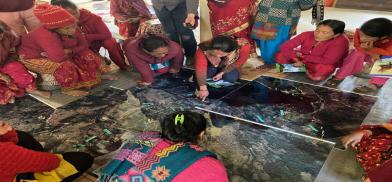NASA images track demographic changes in Nepal
High-resolution satellite imagery of the Himalaya show details as small as livestock grazing in a field. But what they cannot tell you is how communities on the ground are changing because of natural disasters, political upheavals, or migration

High-resolution satellite imagery of the Himalaya show details as small as livestock grazing in a field. But what they cannot tell you is how communities on the ground are changing because of natural disasters, political upheavals, or migration. This is why NASA is supporting a group of anthropologists and geographers to use its images from space of Dolakha in Nepal and other areas of the Himalayas to track these changes so that local governments can plan land use and new infrastructure.
Researchers will use remote sensing data of the region 80km northeast of Kathmandu that was hit by two big earthquakes in 2015 to look into not just the changes in topography and vegetation, but also the impact on the movement of people and how livelihoods have changed with time.
“Satellite images do not show how trade routes change, or the demographic impact of political instability, so what we are trying to do is combine top-down big data with bottom-up ethnographic research for a more nuanced understanding of the changes taking place on the ground,” explains Mark Turin and Sara Shneiderman, both anthropologists at the University of British Columbia (UBC) involved in the project.
Turin and Shneiderman were both involved in the ethnographic study of the Thami people in Dolakha, and say the project will help uncover the “social history” of the district they know so well using remote sensing data over time. The Tama Kosi valley is at high risk due to the danger from the Tso Rolpa glacial lake in the Rolwaling.
The NASA project will be a collaboration between UBC and Yale Himalaya Initiative and will also explore the transformation of Namche Bazar in Nepal, Leh in India and Trongsa in Bhutan – all areas exposed to impacts of climate change, natural disasters, as well as tourism and infrastructure development.
The study will also help bridge the knowledge gap between well-studied changes in the urbanisation patterns of big cities in the Himalayan region and the less-known effects on land use in smaller towns.
Nepal is one of the most densely populated mountain areas of the world, and is vulnerable to the impact of climate change, earthquakes, landslides and floods, conflict, political instability as well as the coping with changes brought about by infrastructure development, tourism and out-migration.
The project team made a field visit to Dolakha earlier this year, but follow-up fieldwork has been delayed because of the coronavirus lockdown. Using satellite images, remote sensing experts, geographers, economists and anthropologists are tracking land-use change in areas like Dolakha.
The district was already feeling the effect of climate change on agriculture, has seen huge investment in hydropower and highways in the past decade, and was at the epicentre of the 12 May 2015 aftershock of magnitude 7.3 that followed the main 7.8 earthquake a month earlier.
“In a nutshell, our preliminary results show that development in the region is highly dynamic and not linear. Urban development is not an end, but a process,” says Karen Seto of the Yale School of Forestry and Environmental Studies and principal investigator of the project.
Combining satellite mapping and on-the-ground research, the group found that human settlements in the Himalaya have seen many cycles of infrastructure development due to factors like disasters, political instability or economic policy.
Seto says although we know more about the big cities, there is not enough data on which towns in Nepal are growing and how fast, and where the vulnerable groups in society are living, especially after the 2015 earthquake.
The population of Himalayan towns and cities has doubled in the past 40 years, and out-migration from rural areas has left farms fallow, and reduced pressure on forests. This demographic shift has had measurable ecological implications with expansion of urban centres along highways, new roads have caused rockslides, adding to the risk.
With the lockdown into its third month in Nepal, there is already significant impact of the return of young migrant workers back to their villages and the drop in tourism on the semi-urban communities in the Himalayan hinterland.
Researchers will be using NASA’s Landsat images at 2.5m resolution as well as recently declassified military spy satellite images from the 1980s. On the ground, economists and sociologists will collect data on health, education, migration and the impact of political changes on the communities.
Says Seto: “The findings will help local governments understand the changes taking place so they can plan safer urban development less vulnerable to earthquakes, landslides, fires. After all, disasters in the Himalaya are not a question of if, but when.”
https://www.nepalitimes.com/latest/nasa-images-track-changes-in-nepal/








Post a Comment